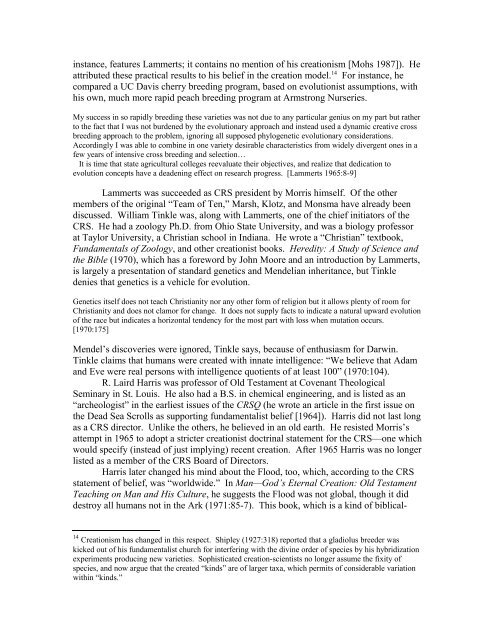Creationism - National Center for Science Education
Creationism - National Center for Science Education
Creationism - National Center for Science Education
You also want an ePaper? Increase the reach of your titles
YUMPU automatically turns print PDFs into web optimized ePapers that Google loves.
instance, features Lammerts; it contains no mention of his creationism [Mohs 1987]). He<br />
attributed these practical results to his belief in the creation model. 14 For instance, he<br />
compared a UC Davis cherry breeding program, based on evolutionist assumptions, with<br />
his own, much more rapid peach breeding program at Armstrong Nurseries.<br />
My success in so rapidly breeding these varieties was not due to any particular genius on my part but rather<br />
to the fact that I was not burdened by the evolutionary approach and instead used a dynamic creative cross<br />
breeding approach to the problem, ignoring all supposed phylogenetic evolutionary considerations.<br />
Accordingly I was able to combine in one variety desirable characteristics from widely divergent ones in a<br />
few years of intensive cross breeding and selection…<br />
It is time that state agricultural colleges reevaluate their objectives, and realize that dedication to<br />
evolution concepts have a deadening effect on research progress. [Lammerts 1965:8-9]<br />
Lammerts was succeeded as CRS president by Morris himself. Of the other<br />
members of the original “Team of Ten,” Marsh, Klotz, and Monsma have already been<br />
discussed. William Tinkle was, along with Lammerts, one of the chief initiators of the<br />
CRS. He had a zoology Ph.D. from Ohio State University, and was a biology professor<br />
at Taylor University, a Christian school in Indiana. He wrote a “Christian” textbook,<br />
Fundamentals of Zoology, and other creationist books. Heredity: A Study of <strong>Science</strong> and<br />
the Bible (1970), which has a <strong>for</strong>eword by John Moore and an introduction by Lammerts,<br />
is largely a presentation of standard genetics and Mendelian inheritance, but Tinkle<br />
denies that genetics is a vehicle <strong>for</strong> evolution.<br />
Genetics itself does not teach Christianity nor any other <strong>for</strong>m of religion but it allows plenty of room <strong>for</strong><br />
Christianity and does not clamor <strong>for</strong> change. It does not supply facts to indicate a natural upward evolution<br />
of the race but indicates a horizontal tendency <strong>for</strong> the most part with loss when mutation occurs.<br />
[1970:175]<br />
Mendel’s discoveries were ignored, Tinkle says, because of enthusiasm <strong>for</strong> Darwin.<br />
Tinkle claims that humans were created with innate intelligence: “We believe that Adam<br />
and Eve were real persons with intelligence quotients of at least 100” (1970:104).<br />
R. Laird Harris was professor of Old Testament at Covenant Theological<br />
Seminary in St. Louis. He also had a B.S. in chemical engineering, and is listed as an<br />
“archeologist” in the earliest issues of the CRSQ (he wrote an article in the first issue on<br />
the Dead Sea Scrolls as supporting fundamentalist belief [1964]). Harris did not last long<br />
as a CRS director. Unlike the others, he believed in an old earth. He resisted Morris’s<br />
attempt in 1965 to adopt a stricter creationist doctrinal statement <strong>for</strong> the CRS—one which<br />
would specify (instead of just implying) recent creation. After 1965 Harris was no longer<br />
listed as a member of the CRS Board of Directors.<br />
Harris later changed his mind about the Flood, too, which, according to the CRS<br />
statement of belief, was “worldwide.” In Man—God’s Eternal Creation: Old Testament<br />
Teaching on Man and His Culture, he suggests the Flood was not global, though it did<br />
destroy all humans not in the Ark (1971:85-7). This book, which is a kind of biblical-<br />
14 <strong>Creationism</strong> has changed in this respect. Shipley (1927:318) reported that a gladiolus breeder was<br />
kicked out of his fundamentalist church <strong>for</strong> interfering with the divine order of species by his hybridization<br />
experiments producing new varieties. Sophisticated creation-scientists no longer assume the fixity of<br />
species, and now argue that the created “kinds” are of larger taxa, which permits of considerable variation<br />
within “kinds.”

















